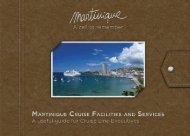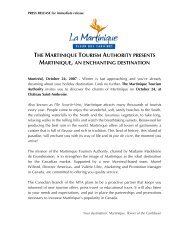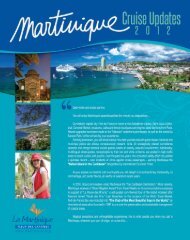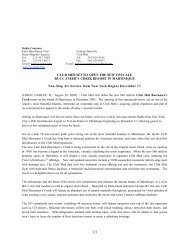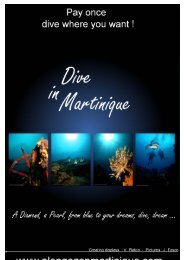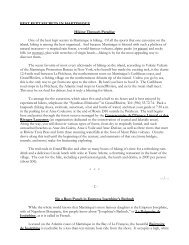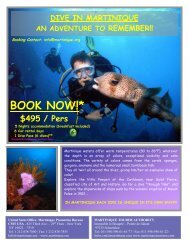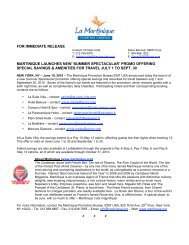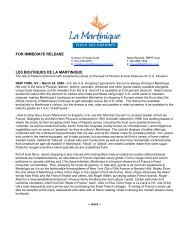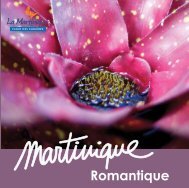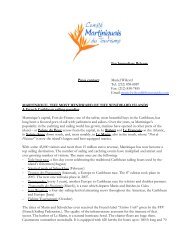sales guide martinique
sales guide martinique
sales guide martinique
You also want an ePaper? Increase the reach of your titles
YUMPU automatically turns print PDFs into web optimized ePapers that Google loves.
The essentials<br />
1/ What is the best season to go to<br />
Martinique ?<br />
Martinique is known as the island of « eternal summer. »<br />
It is blessed with mild temperatures all year long. Even<br />
the sea water is constantly mild, staying between 75<br />
to 85 degrees. The famous « rainy season,» from June<br />
to November, has nothing in common with the Asian<br />
monsoons. You just have to wait for the brief heavy<br />
showers to pass. Hikers during the rainy season may<br />
want to take a <strong>guide</strong> with them, as some of the trails in<br />
the north can become slippery. Those who love sailing,<br />
or other water spots that require wind or waves, prefer<br />
to come to Martinique from mid-December to June,<br />
simply because it’s breezier then. You may have your<br />
own favorite time for visiting, but there is never a bad<br />
time to be in Martinique.<br />
old. » Actually, there are two ways of experiencing<br />
Martinique: One is to stay cosseted within the<br />
island’s ample tourist infrastructure—luxurious hotels,<br />
restaurants, golf clubs, yacht clubs—never venturing<br />
out except on the rare group excursion. The other way<br />
is to leave all that behind and really explore the island,<br />
with its charming fishing villages perched on the green<br />
hills that dot the island, or its northern mountains<br />
crisscrossed with gorges, streams and waterfalls, or<br />
the banana fields stretching along the coast.<br />
5/ What are the major areas of interest to<br />
tourists ?<br />
Hikers love to go everywhere in Martinique. The same<br />
is true for those interested in history and culture. But<br />
visitors interested in swimming and other water sports<br />
generally head for the southern Caribbean coast. Most<br />
of the resorts are there, near the island’s most beautiful<br />
beaches. Here are the major swimming destinations:<br />
- Les Trois-Ilets and Pointe du Bout<br />
- Le Diamant and Sainte-Luce<br />
- Sainte-Anne and Le Marin.<br />
- Trinité and Tartane (an exception to the rule,<br />
located on the Caravelle Peninsula, farther north<br />
on the Atlantic coast)<br />
6/ Is it preferable to rent a car ?<br />
2/ Where are the most beautiful<br />
beaches ?<br />
If you love idyllic beaches, you will be very happy in<br />
the southern part of the island. The entire southern<br />
coast is dotted with one sublime beach after another.<br />
The southeast coast is protected by barriers of coral<br />
reefs, so it has calm gentle waters worthy of the most<br />
secluded lagoon. In the north, you can enjoy the blacksand<br />
beaches of Anse Turin, near Le Carbet, and<br />
especially Anse Couleuvre, near Prêcheur.<br />
If you really want to strike out on your own to explore<br />
the island, a car is a must. And it’s also a pleasure,<br />
given that the roads in Martinique are safe and wellmaintained.<br />
Those who can’t or won’t drive can always<br />
hire a professional <strong>guide</strong>.<br />
7/ Is there a varied selection of<br />
accommodations ?<br />
Lodging in Martinique is diverse, from Deluxe Relais et<br />
Chateaux to quaint affordable B&B.<br />
On the southern coast and in Tartane, there are hotels<br />
of classic good quality, usually two- or three-star<br />
properties, as well as the occasional four-star.<br />
3/ Is the landscape a varied one ?<br />
In fact, one of the principal assets of Martinique is<br />
the amazing diversity of its landscape. Don’t think<br />
that Martinique is only about sand and surf. The wild,<br />
mountainous north is as much worth a visit as any<br />
of the island’s beaches. Swathed in thick, verdant<br />
vegetation, the northern interior is capped by the<br />
towering peaks of Mount Pelée ( 4,483 feet) and the<br />
Pitons du Carbet. This stunning alpine landscape has<br />
been classified as a « regional natural park , » and it’s<br />
a veritable paradise for hikers, nature lovers and those<br />
who simply love beauty...<br />
4/ Is Martinique a true escape, a real<br />
change of scenery ?<br />
The exuberant vegetation and sunshine suffice to<br />
make Martinique an escape from the « same old, same<br />
80



